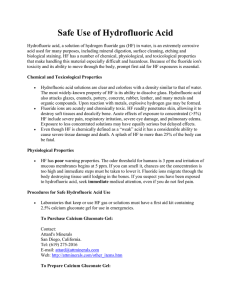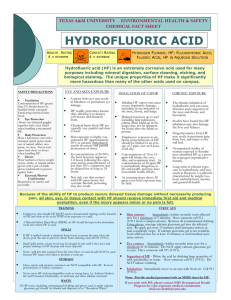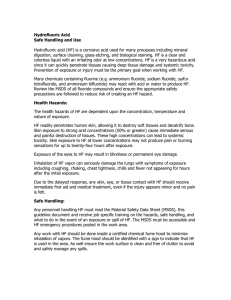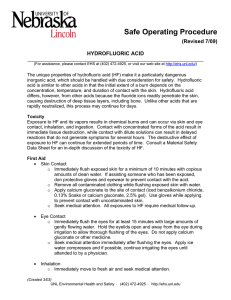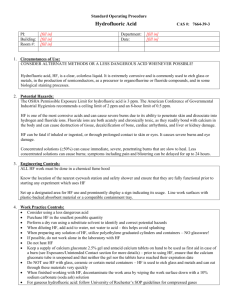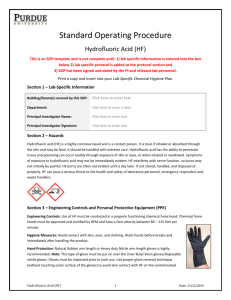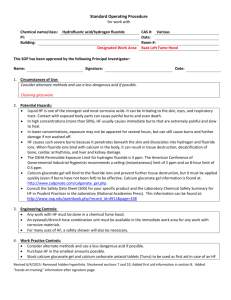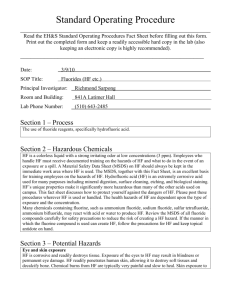Guidelines for the Safe Use of Hydrofluoric Acid
advertisement
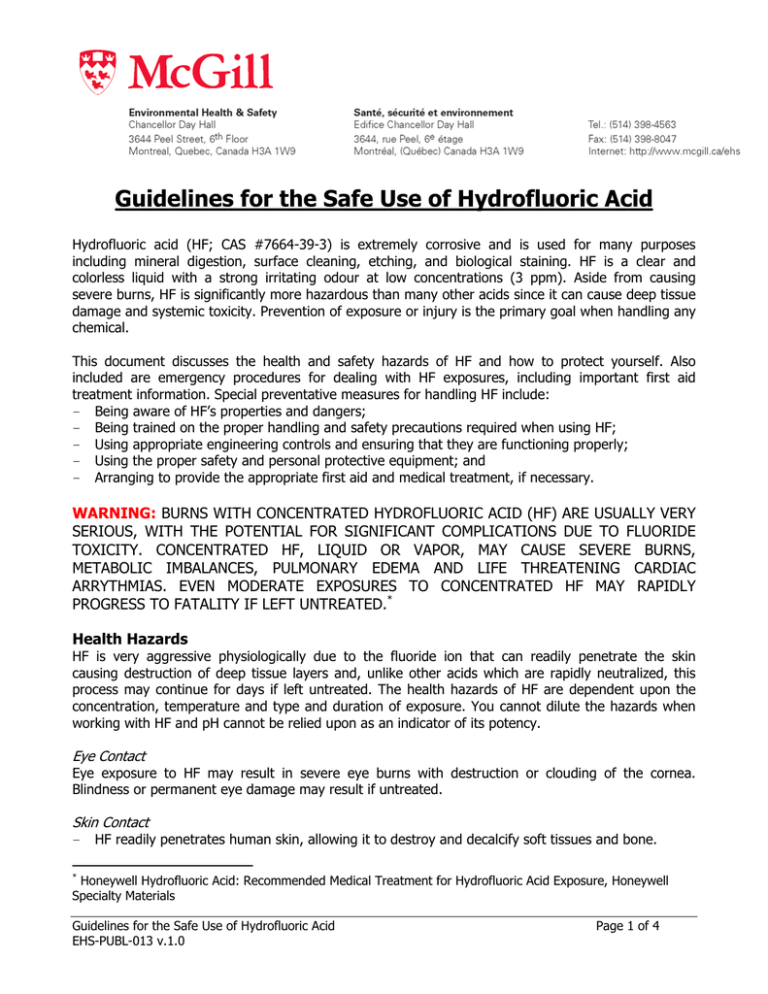
Guidelines for the Safe Use of Hydrofluoric Acid Hydrofluoric acid (HF; CAS #7664-39-3) is extremely corrosive and is used for many purposes including mineral digestion, surface cleaning, etching, and biological staining. HF is a clear and colorless liquid with a strong irritating odour at low concentrations (3 ppm). Aside from causing severe burns, HF is significantly more hazardous than many other acids since it can cause deep tissue damage and systemic toxicity. Prevention of exposure or injury is the primary goal when handling any chemical. This document discusses the health and safety hazards of HF and how to protect yourself. Also included are emergency procedures for dealing with HF exposures, including important first aid treatment information. Special preventative measures for handling HF include: – Being aware of HF’s properties and dangers; – Being trained on the proper handling and safety precautions required when using HF; – Using appropriate engineering controls and ensuring that they are functioning properly; – Using the proper safety and personal protective equipment; and – Arranging to provide the appropriate first aid and medical treatment, if necessary. WARNING: BURNS WITH CONCENTRATED HYDROFLUORIC ACID (HF) ARE USUALLY VERY SERIOUS, WITH THE POTENTIAL FOR SIGNIFICANT COMPLICATIONS DUE TO FLUORIDE TOXICITY. CONCENTRATED HF, LIQUID OR VAPOR, MAY CAUSE SEVERE BURNS, METABOLIC IMBALANCES, PULMONARY EDEMA AND LIFE THREATENING CARDIAC ARRYTHMIAS. EVEN MODERATE EXPOSURES TO CONCENTRATED HF MAY RAPIDLY PROGRESS TO FATALITY IF LEFT UNTREATED.* Health Hazards HF is very aggressive physiologically due to the fluoride ion that can readily penetrate the skin causing destruction of deep tissue layers and, unlike other acids which are rapidly neutralized, this process may continue for days if left untreated. The health hazards of HF are dependent upon the concentration, temperature and type and duration of exposure. You cannot dilute the hazards when working with HF and pH cannot be relied upon as an indicator of its potency. Eye Contact Eye exposure to HF may result in severe eye burns with destruction or clouding of the cornea. Blindness or permanent eye damage may result if untreated. Skin Contact – HF readily penetrates human skin, allowing it to destroy and decalcify soft tissues and bone. * Honeywell Hydrofluoric Acid: Recommended Medical Treatment for Hydrofluoric Acid Exposure, Honeywell Specialty Materials Guidelines for the Safe Use of Hydrofluoric Acid EHS-PUBL-013 v.1.0 Page 1 of 4 – – – – Skin exposure to concentrated HF (50%-100) immediately results in serious and painful destruction of tissue, often followed by blister formation; systemic fluoride poisoning may result. Skin exposure at concentrations between 20% to 50% range may not produce clinical signs or symptoms for 1 to 8 hours. Skin exposure at lower concentrations (typically <20%) may not produce pain or burning sensations until hours after the exposure (up to 24 hours). HF’s ability to produce severe, delayed tissue damage without producing pain, means that all skin, eye, or tissue contact with HF should receive immediate first aid and medical attention, even if the exposure appears minor or no pain is felt. Inhalation Inhalation of HF vapour can seriously damage the lungs. Delayed reactions up to and including fatal pulmonary oedema (flooding of the lungs with body fluids) may not be apparent for hours after the initial exposure. Safety Precautions for HF Use Information and Training Employees and lab personnel who handle HF must read the Material Safety Data Sheet (MSDS) and receive training from their supervisor or a qualified delegate (e.g., chief lab technician) on its hazards and what to do in the event of an exposure or a spill. The MSDS must be kept in the immediate work area where HF is handled and together with these Guidelines used for training. Lab Ventilation HF at concentrations greater than 5% must be handled inside a certified chemical fume hood to minimize inhalation of vapours. Eye Protection Chemical goggles together with a face shield are required when handling HF at concentrations greater than 20%. Safety glasses with side shields may not provide adequate eye protection. Protection Clothing A lab coat, a chemically-resistant apron and protective sleeves are required when handling HF at concentrations greater than 5%. No exposed skin is permitted. Protective clothing can be made of neoprene, fluorocarbon (viton) or other materials - consult the manufacturer’s chemical resistance data when selecting protective clothing. Examples of protective clothing for use with 48% HF: Dupont® Tychem® QC Gloves Gloves should be dedicated for HF use only and must be inspected prior to use; even a pin-hole leak thorough gloves may result in exposure. If gloves become contaminated with HF, remove them immediately, thoroughly wash your hands, and check your hands for any sign of contamination. Contaminated gloves must be disposed of as HF waste. A second pair of nitrile exam gloves should be worn under the gloves for protection against leaks. Neoprene and butyl gloves are known to protect against hydrofluoric acid, however it is important to consult the manufacturer’s glove selection guide when selecting a glove for HF. Examples of gloves for use with 48% HF: Best® Viton® and ChemMaster®; Ansell Sol-Vex®, Neoprene™, Orange Heavyweight and Chemi-Pro®; MAPA Trionic® E-194, Stanzoil® NK-22 and Stanzoil® NK-34 Examples of gloves for use with 60% HF: Ansell Neoprene™ Guidelines for the Safe Use of Hydrofluoric Acid EHS-PUBL-013 v.1.0 Date Prepared: December 14th, 2006 Page 2 of 4 If you have any questions about which protective clothing or gloves to purchase, contact EHS. Eyewash/Emergency Shower A combination eyewash/shower is required within 10 seconds (approximately 55 feet or 16.8 meters) away and must be accessible (unobstructed). The eyewash must be tested weekly. Safe Work Practices It is highly recommended never to work alone when using HF. Eating and drinking are not permitted in any laboratory at McGill. Always wash hands thoroughly after handling HF. Treatment of HF Exposure Calcium gluconate gel is a topical antidote for HF skin exposure and must be on-hand when working with HF. It works by combining with HF to form insoluble calcium fluoride, thus preventing the extraction of calcium from tissues and bones. Calcium gluconate gel has a limited shelf life and must be replaced as it expires. Spill, Storage and Waste Issues Spills – – HF spilled outside a chemical fume hood: Evacuate the area and close the doors. Post a sign to prevent others from entering. Call McGill Security Services (3000 Downtown Campus or 7777 Macdonald Campus). HF spilled inside a chemical fume hood: The spill can be cleaned up by laboratory staff if they have the correct equipment, understand the hazards, know how to clean up the spill safely and dispose of the waste properly. Lime, soda, sodium bicarbonate, or a spill absorbent specified for HF should be used to neutralize and clean up a spill. Add neutralizers slowly as the reaction can be vigorous. Organic spill kits that contain Floor-dri, kitty litter, or sand must not be used because HF can react with silica to produce silicon tetrafluoride, a toxic gas. Storage All HF and HF waste must be stored in properly labelled and chemically compatible containers (e.g., polyethylene or Teflon). Glass, metal, and ceramic containers are not compatible with HF. HF should never be stored with incompatible chemicals such as ammonia or other alkaline materials. Always place in a low traffic area on a low protected shelf or in a labelled cupboard. Waste – – Waste HF should be placed in a chemically compatible container with a sealed lid and clearly labelled. Contact Waste Management Program (514-398-5066 or www.mcgill.ca/wmp) if you have any questions and for disposal of HF waste. Many chemicals containing fluorine, such as ammonium fluoride, sodium fluoride, sulphur tetrafluoride, and ammonium bi-fluoride, may react with acid or water to produce HF. Review the MSDS of all fluoride compounds carefully for safety precautions to reduce the risk of creating a HF hazard. Emergency Procedures for HF Exposures All exposure to or contact with HF must receive immediate first aid and subsequent medical evaluation, even if the injury appears minor and no pain is felt. Speed is of the essence - HF can produce delayed effects and serious tissue damage without necessarily producing pain. Guidelines for the Safe Use of Hydrofluoric Acid EHS-PUBL-013 v.1.0 Date Prepared: December 14th, 2006 Page 3 of 4 WARNING: HF EXPOSURE REQUIRES IMMEDIATE AND SPECIALIZED FIRST AID AND MEDICAL TREATMENT. IF UNTREATED OR IF IMPROPERLY TREATED, PERMANENT DAMAGE, DISABILITY OR DEATH MAY RESULT. CALCIUM GLUCONATE GEL MUST BE AVAILABLE IF HF IS BEING HANDLED. Skin contact 1. Immediately proceed to the nearest eyewash/shower and rinse the affected area thoroughly with water for a minimum of 5 minutes. Remove all contaminated clothing while continuing to flush with water. Speed and thoroughness is of primary importance. 2. While the victim is rinsing the affected area, someone should call 911 for emergency medical assistance. At Macdonald campus, call McGill Security Services (7777). 3. Immediately after thorough washing, start massaging calcium gluconate gel into the affected area. The person administering the gel should wear nitrile gloves to prevent a possible secondary HF burn. Apply gel frequently and massage continuously until pain and/or redness disappears or until medical care is given. 4. During transportation to a medical facility, it is extremely important to continue massaging the calcium gluconate gel. Eye contact 1. Immediately proceed to the nearest eyewash station and flush eye for a minimum of 15 minutes with large amounts of gently flowing water. Hold eyelids open and away from the eye during irrigation to allow for thorough flushing. 2. While the victim is rinsing their eyes, have someone call 911 for emergency medical assistance. At Macdonald campus, call McGill Security Services (7777). 3. Continue to rinse affected area until emergency medical assistance arrives. 4. Do not apply calcium gluconate gel to eyes! Inhalation Vapour exposures can cause skin & mucous membrane burns as well as damage pulmonary tissue. 1. Immediately move the victim to fresh air and obtain medical attention. 2. Call 911 for emergency medical assistance. At Macdonald campus, call McGill Security Services (7777) 3. Obtain immediate medical attention. Ingestion 1. Have the victim drink several large glasses of water, milk or milk of magnesia. 2. Do not induce vomiting. Do not give emetics or baking soda. 3. Call 911 for emergency medical assistance. At Macdonald campus, call McGill Security Services (7777). 4. Obtain immediate medical attention. Ingestion of HF is a life-threatening emergency. In all cases of accidental exposure, you must bring a copy of the Material Safety Data Sheet; the emergency room physician may be unaware of the treatment measures for HF. All accidents must be report to your supervisor and to Environmental Health & Safety via the Accident, Incident, and Occupational Disease Report Form available on the EHS website at www.mcgill.ca/ehs/forms/forms/accident_incident_report/#1. References: University of Pittsburgh, Guidelines for the Safe Use of Hydrofluoric Acid, Sept. 2004 Recommended Medical treatment for hydrofluoric acid Exposure. Honeywell Chemicals. Guidelines for the Safe Use of Hydrofluoric Acid EHS-PUBL-013 v.1.0 Date Prepared: December 14th, 2006 Page 4 of 4
